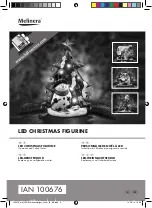
Checkout and Adjustment
Manufactured for GE Lighting
General Electric Company
Nela Park Cleveland, OH 44112
1-877-584-2685
www.gelightingcontrols.com
© 2011 GE
Limited Warranty
GE warrants that the product will be free from defects in material, workmanship, and title. This warranty applies only to
defects that appear within five (5) years from the date of GE’s invoice (except for defects in title, which shall have no time
limitation). If the product fails to meet the above warranties and if Purchaser notifies GE in writing within thirty (30) days
after discovery of the defect, then GE shall correct such defect by either (at GE’s option) replacing the defective part or
product (f.o.b. GE’s plant or other point of shipment, with freight allowed to destinations within the continental United
States, Alaska and Hawaii) or refunding the price. The foregoing warranties apply only to product purchased directly
from GE, and do not apply to failures caused by acts of God or as a result of any improper installation, maintenance,
storage or service, any accident, abuse, misuse, abnormal use, modification, misapplication, use in violation of any ap-
plicable standard or code, any failure attributable to any associated or complementary products not supplied by GE, or
any failure to comply with any applicable recommendations of GE. GE reserves the right to examine the failed product
to determine the cause of failure. THE FOREGOING WARRANTIES AND REMEDIES ARE EXCLUSIVE AND SHALL CONSTITUTE
THE SOLE REMEDY OF PURCHASER AND THE SOLE LIABILITY OF GE WITH REGARD TO DEFECTS IN, OR FAILURE OF, THE
PRODUCT WHETHER THE CLAIM IS IN CONTRACT, INDEMNITY, WARRANTY, TORT (INCLUDING NEGLIGENCE), STRICT LIA-
BILITY OR OTHERWISE. GE MAKES NO OTHER WARRANTY, STATUTORY OR OTHERWISE, AND NONE IS TO BE IMPLIED. IN
PARTICULAR, WITHOUT LIMITING THE FOREGOING, NO WARRANTY OF MERCHANTABILITY OR FITNESS FOR A PARTICULAR
PURPOSE IS MADE OR IS TO BE IMPLIED.
Res. #9590812
Printed in USA
DIP Switch Settings
Wiring Diagram 1: One switchpack, one sensor - occupancy control with manual switch option
Troubleshooting
LED will not turn ON:
• Verify 10-30 VDC across the red and black wires of the sensor.
• Unless connected to a momentary switch for manual control, ensure that DIP switch 1 is in
the default position.
• If there is no power at the sensor, check for 12-18 VDC at the switchpack output and 120 VAC
or 277VAC at the switchpack input. Verify correct primary connections.
• If the voltage is OK at the switchpack, recheck all wiring and connections.
• If the LED still does not operate, please contact technical service.
Lights will not turn ON:
• Confirm that no other switches or equipment are interrupting or bypassing power to the
switchpack or load.
• Unless connected to a momentary switch for manual control, ensure that DIP switch 1 is in
the default position.
• Short the blue and red switchpack control leads together to energize the relay.
• If the lights turn on, contact technical service.
• If the lights do not turn on, check wiring on the switchpack load side and check the switch-
pack contacts for continuity. Replace the switchpack if necessary.
Lights will not turn OFF:
In smaller rooms, the sensor may be activated by people moving in the hallway outside the
room. Adjust the Sensitivity control toward minimum to prevent this or relocate the sensor. If
the lights will not turn OFF after the time period set on the sensor, and the LED has not lit dur-
ing the time period:
• Confirm that no other switches or equipment are interrupting or bypassing power to the
switchpack or load.
• Make sure DIP switch 4 is in the default position, and the bypass switch is in the “Auto” posi-
tion.
Note: If multiple sensors/switchpacks are installed, check one at a time.
Manual-On Override Switch:
The sensor has a built-in override switch on the printed circuit board designed to turn the load
on in the event of sensor failure when the sensor can not be replaced immediately. The switch-
pack must be operative for this switch to work. If the switchpack is defective, it must be re-
placed or bypassed to activate the load. To operate this switch, remove the cover of the sensor
and move the override switch from the “auto” position to the “on” position. All switchpacks
connected to the sensor will now be energized. If multiple sensors control the same switch-
pack(s), activating the override switch on any one sensor will activate all of the switchpacks.
Sensor Cover Removal:
1. To remove the cover from the sensor unit, grasp the corners and pull down gently. Unit will
snap open.
2. Locate the manual-on override switch and move to the “Auto” to “On” position. “Auto” posi-
tion is towards the wire harness. “On” position is away from the wire harness.
3. To replace the cover, position controls to line up with the holes in the center of the cover.
Unit will snap closed.
1. Dip Switch Controls are located under the door on the face of the sensor. Before opening
the door, review factory settings to determine if changes are necessary. The factory setting
on all switches is the OFF position.
If you elect to change some of these settings, open the door using a screwdriver.
2. Verify that DIP switch 10 is in the “Off” position to ensure the sensor is not in override mode.
3. Stand completely still or leave the room. In approximately 15 seconds, the lights will go out.
4. Test the area of coverage by watching the LED on the sensor. The red LED lights when the
sensor is detecting motion.
5. Using the chart at right, set the time delay to the desired time for
the lights to remain on after the occupant leaves the covered
area. Minimum setting is approximately 15 seconds (for installer
testing); maximum is about 30 minutes. The recommended time
delay is usually six to ten minutes. In applications where motion
is minor the sensor may need a longer time delay. If the lights go
out while the room is occupied, increase the time slightly until
optimum time delay is reached.
6. If you choose to disable the Self-Adjust feature, move DIP 4 up-
wards to the “on” position.
7. Using the chart at right, set the ambient light level. Select the foot-
candle level at which ambient light will be sufficient and artificial
lighting will be unnecessary. At this level the sensor will not switch
lights on when motion is detected. If you do not want ambient light
to impact the sensor, select the off setting. If lights go on when
there is adequate ambient light, decrease the footcandle setting.
8. If application involves the use of HID lamps, set the HID Interface Control to ON for proper
HID Load Control. If fluorescent and incandescent lamps are used, set the HID Interface
Control to OFF.
9. To avoid having lights controlled by the sensor swept on by a BAS or EMS, set the Lighting
Sweep Control to ON.
10. If connecting directly to a BAS system which does not provide pull-ups, select the Pull-Up
Option by moving DIP 9 to “on.” This will allow the sensor to signal the BAS when there is
occupancy and will avoid the need for additional wiring at the system panel.
1
4
3
2
Off
On
1
Time Delay
4
Self Adjust
3
Time Delay
2
Time Delay
5
8
7
6
5
Light Level
6
Light Level
7
HID Interface
8
Lighting Sweep
9
Pull-Up
1
10
9
1
3
2
0.25
6
10
14
18
22
26
30
Switch No.
Time Delay
(Minutes)
Technical Service: 1-877-584-2685
Wiring
CAUTION: Before installing or performing any service on a GE system, the power MUST be turned
off at the branch circuit breaker. According to NEC 240-83(d), if the branch circuit breaker is
used as the main switch for a fluorescent lighting circuit, the circuit breaker should be marked
“SWD.” All installations should be in compliance with the National Electric Code and all state
and local codes.
NOTE REGARDING COMPACT FLUORESCENT LAMPS: The life of some compact fluorescent lamps
(CFLs) is shortened by frequent automatic or manual switching. Check with CFL and ballast manu-
facturer to determine the effects of cycling.
CAUTION: For use with 10-30 VDC only. For other voltages, refer to GE Tech Sheets. Do not wire to
control receptacle circuits. Confirm supply voltage before wiring the switchpack. Make sure the
switchpack is the correct model for the voltage being used. VERIFY that the connected load does
not exceed the switchpack ratings. Use twist-on wire connectors for all connections. All installations
should be in compliance with the National Electric Code and all state and local codes.
DO NOT control more than ten switchpacks with a single sensor.
GE sensors are provided with Teflon-insulated pigtails. The components are interconnected using
18 AWG Class 2 wiring per NEC 725. Use UL-recognized Teflon insulated wire approved for
plenum areas per NEC 725-2(b) where required.
Wire the sensor(s), switchpack(s) and load as shown in the Wiring Diagram.
Controlling Multiple Circuits: CAUTION: In situations where an office is wired for multiple circuits
using separate hot leads, it is very important to connect only one circuit to each switchpack. You
may combine the low voltage wiring from switchpacks connected to different circuits. Consult
with the building manager and occupant to determine which lights should be off when the toggle
switch is open.
5
6
Off
3
5
Switch No.
Light Level
(FC)
10
Measured at 30” off the ground.




















